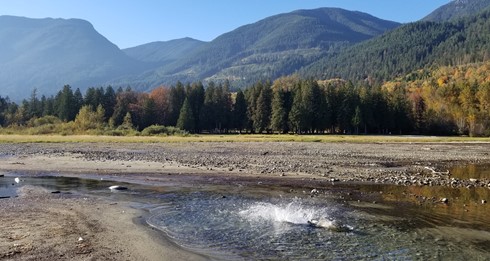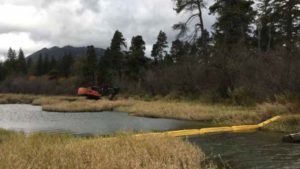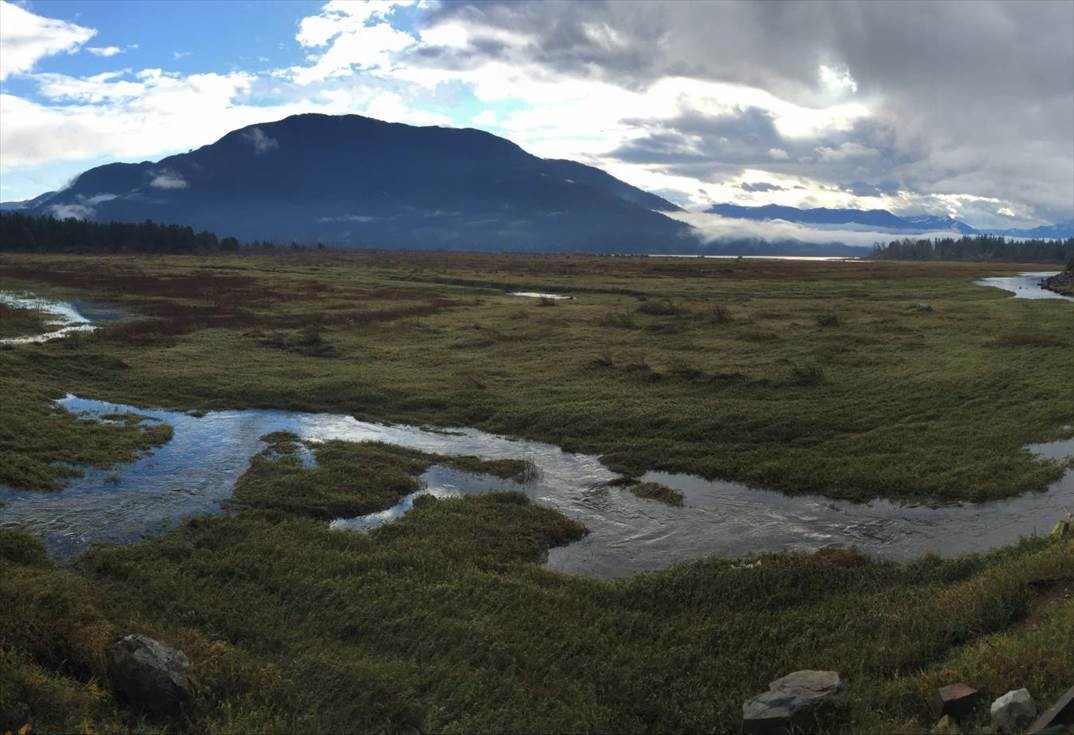

This restoration project is a collaborative effort to enhance, restore and promote shared conservation values in the Heart of the Fraser. Specifically, this project will enhance and restore juvenile and adult Chum and Chinook salmon, improve ecological resiliency in the area and work to support the recovery of critical food sources for the southern resident orca whale population.
Starting around 2015/2016 funded by the FHRI, EcoAction Canada, and AFSAR - Leq’a:mel First Nation connected with Fraser Valley Watersheds Coalition and Fisheries and Oceans Canada to help identify opportunities to revitalize salmon habitat in the Nicomen Slough.
Historically, prior to 1930’s, the Nicomen Slough was connected with the Fraser River and was exposed to open flushing river flows that would clean salmon spawning gravels. However, changing land use pressure led to dramatic alteration of the channel and adjacent floodplain by diking, road and rail construction, and construction of a causeway to Nicomen Island, ultimately turning the open channel into a slough. Now, 90 years later, the Nicomen Slough still supports important biological and ecological value, yet is realizing pressures of succession.
In the first four years of the project, studies to identify opportunities for enhancement of key areas of the slough to benefit salmon and aquatic biodiversity was completed. This work included background assessments and monitoring, stakeholder meetings, and engagements. This work addressed overarching questions about the hydrology (flow of water), biology and distribution of known rare species and identification of infrastructure and social/cultural components to be incorporated into the potential restoration designs. In addition to identifying restoration opportunities, this work involved significant community engagement and outreach events, incorporating environmental and biological values into Leq’a:mel First Nations land management plans, supported short-term operational training on invasive species, soil and biodiversity and had microsite enhancements (planting events) to support natural spaces and outdoor learning classrooms. At the end of this phase, opportunities and limitations were identified and help set the stage for implementing some actions, pending further financial resources.
In 2019, financial contributions from DFO’s Coastal Restoration Fund were approved to begin implementing restoration activities within the slough to benefit chinook and chum salmon and other salmon related priorities within the “Heart of the Fraser.” This formed a collaborative partnership between Leq’a:mel First Nation, Sqwelets First Nation, Sts’ailes First Nation, Ducks Unlimited Canada, Fisheries and Oceans Canada, Fraser Valley Watersheds Coalition with support from Pearson Ecological, Hemmera Consulting, Marhag Consulting, District of Kent, Fraser Valley Regional district, Province of British Columbia and the local communities groups.
1. Planning for, Implementation of and Effectiveness Monitoring for Nancy and William Phillips Slough within the Sts’ailes First Nation IR lands.

photo credit: Hemmera
Summary of Activity
Lead by Sts’ailes First Nation planning for and implementation of construction of two historic groundwater sloughs Nancy & William Phillips was completed. Historically, the Chehalis River had an active alluvial fan that shifted hydrological movement throughout the fan. This movement of water by periodic pulsing river flows and groundwater recharging is what refreshed the distributaries (sloughs) throughout the fan and kept them open for salmon and aquatic species. However, in order to protect First Nation land and sensitive cultural sites from the erosive, powerful river flows, a section of river was diked. This caused some of the sloughs to become truncated from these flows and undergo successional processes that resulted in loss of aquatic habitat. A win-win solution: The restoration activities associated with this work ensured the historic protective measures to keep the First Nation community safe from natural river hazards remained intact, while efforts to re-excavate these sloughs to support spawning, rearing and overwintering habitat for coho and chum salmon, and rearing habitat for the juvenile Harrison Chinook salmon was achieved.
Read the reports below for more information
2. Planning for Bateson Slough and Traditional Ecological Knowledge (TEK)

photo credit: Pearson Ecological
Summary of Activity
Lead by Sts’ailes First Nation, with support from Hemmera, Pearson Ecological, Fraser Valley Watersheds Coalition and the District of Kent, an investigation on the ability to restore and reconnect Bateson slough, located on the lowlands west of Mount Woodside, to support out-migrating juvenile Harrison Chinook salmon was explored. In addition, other potential restoration and enhancement opportunities were investigated including reconnecting sloughs with old/failing flood structures and/or creating new groundwater and rearing slough systems.
Read the reports below for more information
Sq'éwlets Baseline Survey Report 2020 Pearson Ecological
Local Restoration Planning Sts'ailes-Sq'éwlets Area Salmon Sloughs
3. Complete a Scope of Engagement Process and Draft Framework to Update the Wildlife Management Plan for Lhá:lt/Harrison-Chehalis Wildlife Management Area (WMA)

photo credit: Eric Balke
Summary of Activity
Lead by South Coast Conservation Land Management Program (SCCLMP) (a program shared by Ducks Unlimited Canada, Nature Trust BC and the BC. Provincial Government), the Lhá:lt/Harrison-Chehalis Wildlife Management Area (WMA) is being updated to better reflect ecological, cultural, social values and management needs into the future.
Read the report below for more information
LHCWMA review of 1997 management plan and guidance for update
4. Implement Salmon Spawning Habitat Gravel Augmentation at Sqwuakum Creek (Lake Errock Outlet channel)

photo credit: Fraser Valley Watersheds Coalition
Summary of Activity
Lead by the Fraser Valley Watersheds Coalition with support by DFO RRU, new spawning gravels were augmented at the outlet of Lake Errock to promote salmon spawning particularly for Coho and Chum. In addition, replanting, bioengineering efforts and invasive plant control were initiated around areas of the lake to encourage green lake shores and bank stability.
Read the following report for more information
The works associated with the Nicomen Slough were scheduled to begin in summer of 2020 focusing on two key areas: Skumulapsh Slough and Norrish Fan.
However, the implementation team lost some capacity related to a serious accident to the senior DFO biologist, the retirement of the DFO engineer and then the world was impacted by the COVID-19 global pandemic. These resulted in the delay of activities but there was a silver lining:
Coming soon

This is a block of text. Double-click this text to edit it.